
Letter from Mainadal (At the time of Covid-19)
This essay is based on a post written on Facebook on 30 May 2020, by Milan Mitra Thakur of the Mitra Thakur family of kirtan singers of Mainadal in Birbhum. They have been traditionally singing kirtan for almost 500 years, their lives revolving around their temple of the sixteenth century Bhakti saint Sri Chaitanya Mahaprabhu. They call it their ‘Thakurbari’.
We met Milanda for the first time 2014, and have become good friends since. One of the things we often talk about is the question of archiving their history and musical heritage. Milanda points to the growing interest within the family in their own history and heritage and credits it to our first visit, when they had learned about their ancestors’ voices kept in the British Library’s sound archives in London. The recordings were made in their village by the Dutch scholar and recordist Arnold Bake in 1933; the Mitra Thakurs had no idea about their existence. Just encountering them–three-minute recordings, which were not particularly audible–stirred something. The value was more because the cylinders held their ancestors’ voices. Five years on, their impact can be measured in terms of the memory they unleashed, leading them to open old trunks and drawers for old songbooks, photographs, letters, searching for some audio cassette that no longer plays.. . . and building their own archives.
Milanda says that our trip was especially important because we went to them at a time of ‘closure’. What does he mean by closure? The year after our visit, a tragedy happened in the Mitra Thakur family. We have written about this elsewhere on this website. But just to recapitulate: on our first visit we had recorded the young and dynamic Nityananda Mitra Thakur, or Nitai as they called him. We had gone to Mainadal during Nandotsav (festival celebrating the birth of Lord Krishna). Nitai was performing with his troupe. After his performance, we sat down and talked about Bake’s recordings. The next year Nitai had a heart attack during a performance and he died; that was a huge loss for the family for they were looking up to him as one of the main people who would keep the tradition alive. There are others of course, beautiful singers like Nirmalendu Mitra Thakur, but Nitai was younger. So there was a lot of hope pinned on him. Where will the music go in ten years? Milanda keeps asking.
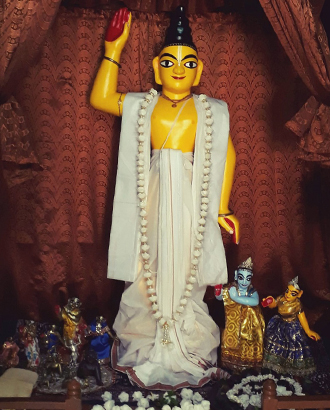
From Milan Mitra Thakur’s Facebook post, 31 May 2020. He writes: ময়নাডালের মহাপ্রভু। আজকের ছবি, বেলা ১টায় ভোগ দর্শনের পর।
When Arnold Bake had visited their village nearly a hundred years ago, every other male member of the family was attached to the art of the kirtan. You can see this from the number of people Bake recorded. Within this faith-based community, music is one of the main things they did for a living, besides running a temple and a residential school of kirtan in the village. Now the family has broken up and dispersed, some have gone into other professions, and the material conditions of village life in Bengal have also changed. For a family that has been hardly recorded, what does this mean for the future? Will there remain any sonic trace of their song? What sonic trace of their past do we have with us now? Except for the wax cylinders of Bake or a recording that musicologist and field recordist Deben Bhattacharya made in 1954, there is almost nothing we can lay our hands on. A private recording with someone, an unplayable audio cassette, but nothing substantial. The brothers Nabagopal and Gobinda Gopal Mitra Thakur sang on the radio, but where can we find those recordings? Even with the Bake cylinders or Deben Bhattacharya recordings–yes, they were precious and the Mitra Thakurs take huge pride in them now, but those three minute tracks could not be a real representation of this elaborate and complex system of music. Deben Bhattacharya’s recording was closer to the way they performed, although truncated, but what did they know in the village about those ethnographic albums which were released for a Western audience?
In the past such thoughts about archiving or continuity were probably irrelevant to Mainadal, because the music was alive and thriving in the community. The community itself was the archive, passing down its musical knowledge from one generation to another. What use did they have of recordings? Bake was very well looked after when he went to the village, as we know from his letters, and everyone was keen sing into his machine. The moment of the recording must have been very exciting for them too–a tall white man in their village, with his machine and his accented Bangla–it must have been an extraordinary event. But were they aware of what would happen once they had sung into the phonograph? Were they expecting to get copies of their songs or photos? Even if they had copies of the recordings, what would they do with them? Bake did send them copies of the photographs though, for Milanda has now dug out some old photos of Mainadal and Bake’s photographs are part of his find. Things are different now. You can send a recording as a file and mostly they will be able to listen, keep and share. They can also make their own recordings. The irony is that, while recording and listening are democratised now, there are fewer good musicians to record. It is quite clear to the Mitra Thakurs that the old patriarchal system of cultural inheritance might not work for much longer (they do not let their daughters sing). When we went to them, they were already beginning to see that they could no longer take the continuity of this music for granted. They were regretting that none of their forefathers, the old masters, had been properly recorded; as if they had lost an opportunity to show their real glory.
The time of our first trip to Mainadal was significant also because, close on our heels the British Library Sound and Audiovisual archives (BLSA) officially repatriated Bake’s Mainadal recordings, after we had helped them to make the connection. Subsequently their own researcher, ethnomusicologist Christian Poske, went and conducted a Bake restudy in the village. It was a special moment for them, to have a representative of such a huge institution visit them. Just as Arnold Bake’s visit must have been for Haridas, Sanketbihari, Gobinda Gopal or Kaliakantha Mitra Thakur, father of Nirmalendu Mitra Thakur, then only a boy.
Milanda and Poske mutually posted photos of his visit on Facebook; Facebook and Youtube are our new archives. Over the past two years Milanda and Nirmalda have been quite active on social media. Sometimes they post old and new recordings of songs and photographs on their walls. So, on 30 May 2020, Milan Mitra Thakur wrote a post about their temple-village at the time of the Covid-19 lockdown.
Different branches of the large Mitra Thakur family take turns to do their temple duties, which includes feeding lunch to visitors every single day of the year. On a regular day, they might feed up to fifty people or more. Family members share expenses, but consider it a religious duty to do this. This time, at the end of May, over two months into the lockdown, it is Milanda’s turn to organise this ritual feeding. However, this time everything is different; everything is changed. During this lockdown, the temple gates are locked and while food is still being cooked, only a few family members are gathered to sing and eat. The temple is uncommonly quiet, MIlanda writes in his post. The gods must also feel rested, There are some photos and a video. The temple looks deserted. Milanda writes that in the last 450 to 500 years, never has it been this way.
I wrote a response to this post, saying, the gods might also be lonely. After all, they are used to watching the sharing of food and music that happens on the temple grounds throughout the year. What is a god without devotees? ‘I am glad you asked this,’ he replied, reiterating, ‘I have been thinking about how our music is on the brink of disappearance.’
Milan Mitra Thakur might hate to say this, but he also has the wisdom that allows him to make this observation. Unlike many of his uncles and cousins, he is not a musician (he will join the others in their ritual choral singing; it is something that all male members of the family still do.). Perhaps his not being a singer has in effect made him freer to think, not merely as a devotee, but also as an intellectual and an outsider. Milanda studied painting at Kala Bhavan, the art school in Santiniketan, stepping for the first time into a world beyond Mainadal. He would take back interested friends to his village home, including foreigners, sometimes to their annual festivals. That was the beginning of a new and critical journey into his old and familiar world. After graduating, he went to work as an art teacher in a residential school in Bihar. He is retired now and spends his time between Mainadal and Bolpur–he maintains that dual life, valuing both the old given world he was born into, as well as the later one of his own making. Nirmalendu Mitra Thakur, perhaps the best living exponent now of the Mainadal style of kirtan singing, jokingly calls this older cousin ‘Manager’. The name is significant. Milan Mitra Thakur will ‘manage’ matters for Mainadal; he will intellectualise the repertoire that Nirmalda and others perform, he will deal with visiting scholars, he will keep digging into the past for remains of their old sound, and take his finds to places and people far away.
31 May 2020
Relevant links:
—————————————————————————————————————————————————————–
৩০শে মে ২০২০। ফেসবুকে কথোপকথন- মৌসুমী ও মিলন মিত্র ঠাকুর।
মিলন দা: ‘লকডাউন’ এ আমাদের ঠাকুরবাড়ি ও ঠাকুরসেবা। আমার ছ’ দিন সেবার পালির আজ তৃতীয় দিন। আজ সকাল হতে সন্ধ্যে , এমন ছবি এমন নিরানন্দ ভাব আমাদের পরিবারের ঠাকুরসেবার সাড়ে চারশ’/পাঁচশ’ বছরের ইতিহাসে আর কখনো ঘটেছে বলে মনে হয়না যেমনটি এই তিন মাস ধরে (21 মার্চ হতে) এইভাবে চলছে। তবে মন্দের ভালো এই যে মন্দিরের ঠাকুর এখন পরম শান্তিতে আছেন এমন প্রশান্তি আগে পাইনি।
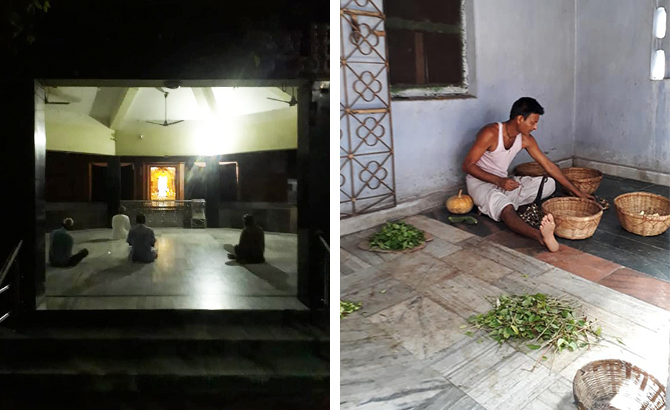
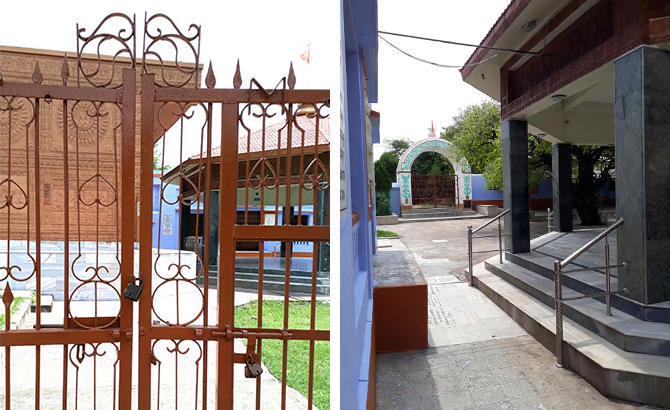
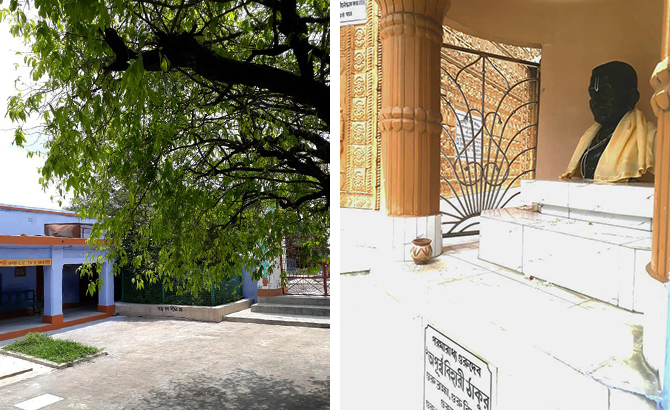
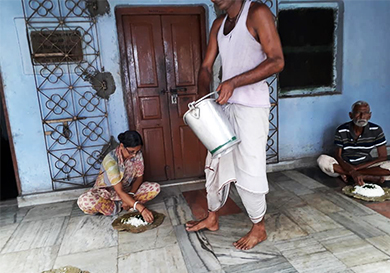
মৌসুমী: কী জানি, মিলনদা? পরম শান্তিতে আছেন কি না? কেউ আসে না, কারো সঙ্গে দেখা হয় না, বাইরে মানুষের ভিড় নেই, অনেক মানুষ একসঙ্গে বসে পাত পেড়ে খাচ্ছেন না, কথাবার্তা হৈ হট্টগোল নেই । আপনার ঠাকুরেরও হয়তো একা লাগছে।
কিন্তু একটা অন্য কথা বলি। আমি এই ছবিগুলো ব্যবহার করতে পারি আমার লেখায়? আপনাদের ময়নাডালের ডাইরিতে এই লেখাটা রাখতে চাইছি। এই ভিডিওটা খুব জরুরি। এই যে আপনাদের এই space, সেই spaceটি এক সময় পোড়া মাটির মন্দির, আর আশপাশের চেনা মানুষদের–পরিবার আর ভক্ত–এইসব উপস্থিতি আর কীর্তন, কথাবার্তা, চলাফেরা–এ দিয়ে নির্মিত হতো। তারপর সেই পুরনো মন্দির ভেঙে গেল, নতুন মন্দির মার্বেল, সিমেন্ট, কাঁচ দিয়ে তৈরি হলো আর পোড়া মাটির কাজ decoration হিসেবে মন্দিরের বাইরের দেয়ালে লাগানো হলো। ভিড় বাড়লো, চেনা মানুষের ভিড়ের বদলে অচেনা মানুষও আসতে লাগলেন। সেই ভিড় সামলানোর জন্য space-এর designও পাল্টানো হলো, লোহার গেট লাগানো হলো। এইসব ধাপে ধাপে হয়েছে। সাড়ে চার শ’ বছরে একেবারে একই রকম তো থাকেনি কিছুই। থাকতে পারেও না। শুধু আপনাদের গান আর সুর আর গায়ন আর ভাব হয়তো একই রকম থেকে গেছে। আমরা তো এখন আর্কাইভের দৌলতে প্রায় এক শ বছরের রেকর্ডই শুনতে পাচ্ছি। আপনারা বলেন, প্রতি বার নন্দোৎসবে গিয়ে মনে হয় যেন যেখানে আগের বছর শেষ হয়েছিল সব, সেখান থেকেই আবার করে শুরু হলো, যেন কেউ কোত্থাও যায়নি, শুধু মাঝখানে একটা বছর চলে গেছে। এই কথাটা আমার খুব মনে ধরেছিল যখন প্রথম শুনেছিলাম। কিন্তু আসলে তো এক একটা বছর চলে যায় আর অনেক কিছু পাল্টিয়েও যায়। আমি সেই কথাই ভাবি; যে, আপনাদের ওখানে কোন জিনিসটা পাল্টায় আর কী কী একই জায়গায় দাঁড়িয়ে থাকে?
হয়তো, আপনাদের যে এত নিয়ম, এতসব রীতি, বছর ধরে, ঋতু ধরে ধরে, গল্প আখ্যান ধরে ধরে, টেক্সট ধরে ধরে, কিসের পর কী গাওয়া হবে, কিসের পর কী করা হয়, এই যে গোটা বছরটা একটা নিয়মের শৃঙ্খলায় বাঁধা, তাতেই একভাবে অনেক কিছু পাল্টাতে পারে না। সেটাই বাঁধের কাজ করে, আপনাদের ভেসে যেতে দেয় না। আবার, এই সারা বছরের ভিতরেও নানা সুর আছে। পাবলিক ডিসকোর্সের সময়, আর প্রাইভেট আলাপচারিতা, দুইই আছে আপনাদের মন্দির-কেন্দ্রিক জীবনের ভিতরে। আমরা যখন নন্দোৎসবের সময় রেকর্ড করেছি তখন সেই ভিড় আর মাইক্রোফোনের ভিতরে যেমন রেকর্ডিং হয়েছে, আর নিয়ম সেবার সময় যখন করেছি, অল্প ক’জন মানুষ, আরাম করে গাওয়া গান, সে আর এক রকম হয়েছে। তারপর, ঘরের ভিতরে ক্লাস নেবার মতন করে নির্মলদা, ওঁর দাদার গান আর খোল বাদন– সে আর এক রকম, intimate, personal, one-to-one। আপনার এই ছবিগুলি দেখে আর লেখা পড়ে আমার মনে হচ্ছিল, আসলে এই কোভিডের সময় যেটা হলো, তা হলো, আপনাদের এই নিয়মের জীবনে একটা ছেদ পড়লো। আজ আপনারা একা একা লোহার গেটে তালা লাগিয়ে ভিতরে নিজদের মতন গান গাইছেন। গান হয়তো একই গাইছেন, কিন্তু সেই গান আর এক থাকছে না। কারণ সেই গান তো মানুষের উপস্থিতিতে, সক্রিয় শ্রবণের ভিতর দিয়ে অথবা তার নিছক ঘুরতে ফিরতে কানে আসা, মনে নেওয়ার ভিতর দিয়ে রূপ পায়। সেই রূপটাই পাল্টে গেছে এখন। হয়তো আবারো একই জায়গায় ফিরে যাবে সব কিছু, অথবা হয়তো আর কিছু হবে এই রোগভোগ যেদিন শেষ হবে সেদিন। এই সবই দেখছেন আপনাদের ঠাকুর। কারণ, তিনিই সেই মাটির ঘর তৈরি হয়নি যখন, সেই সময় থেকে একটানা দেখে চলেছেন। সময়ের দিকে তাকিয়ে আছেন। হয়তো এর পর কেমন সময় আসবে, তার কথাও তিনি জানেন। হয়তো তিনিই সময় আসলে। আপনি জানেন আমি আপনাদের মতন বিশ্বাসী মানুষ নই, কিন্তু যে গল্প আর বিশ্বাসকে ঘিরে আপনাদের জীবন আর যাপন, তা আমায় টানে। তালার ওপারে গান দেখে তাই কেমন যেন মায়া লাগলো।
মিলন দা: মৌসুমী, অপূর্ব লিখেছ । জানতাম তোমাকে নাড়া দেবে এই সময়ের আমাদের ঠাকুরবাড়ির ছবি। সময়ের সাথে সাথে এই যে পরিবর্তন আজ চূড়ান্ত পর্যায়ে এসেছে যদিও টিকে আছে মাত্র । হয়ত সময় হয়েছে বিশ্লেষণ করার আর এই কাজ তুমি করলে তার অন্য মাত্রা হবে সেজন্যই তুমি অবশ্যই লিখবে মৌসুমী, এই সময়ের আরও ছবি তোমাকে পাঠাবো।
ছবি ও ভিডিও: মিলন মিত্র ঠাকুর
- Sound Expeditions : Recording Tarak Das Baul in Kenduli
- Letters from Mainadal
- Raka Banerjee – Songs from the Tea Gardens
- Mary Frances Dunham’s work on jarigan songs.
- Muhammad Ali Ahsan’s recordings, আলীর ডাইরি
- Surojit Sen writes about his experience of engaging with fakiri songs
- Debdas Baul on Bhaskar Bhattacharjya, documentary filmmaker, who worked on the bauls.
- Video extracts from Ruchir Joshi’s 1992 film on the bauls, Egaro Mile (Eleven Miles) and his letter about making the film
- Soumya Chakravarti account of recording folk singer Anantabala Baishnabi in 1968.
- Arnold Bake’s 1932-33 films and audio recordings from Bengal
- Interview with Amy Catlin Jairazbhoy
- Extracts from Khaled Chowdhury’s interview
